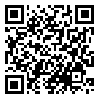BibTeX | RIS | EndNote | Medlars | ProCite | Reference Manager | RefWorks
Send citation to:
URL: http://tbsrj.mazums.ac.ir/article-1-3519-en.html
2- Department of Biology, Islamic Azad University, Tonekabon Branch, Tonekabon, Iran
3- Assistant Professor, Department of Biology, Islamic Azad University of Tonekabon Branch, Tonekabon, Iran
Background & Objectives: Today, major progress has been made in molecular
experiments. The first step towards improving these experiments is the accurate
extraction of nucleic acid. In this study, a protocol for DNA extraction was proposed
in accordance with silica gel method. DNA purification, developed based on the
silica-gel-membrane technology, is a simple method, which involves three stages of
binding, rinsing, and recycling. Nucleic acids, unlike polysaccharides and proteins,
are absorbed by silica gel in the presence of chaotropic agents and are removed
through rinsing. Following the stage of rinsing, purified nucleic acids are extracted
from silica gel through rinsing with buffer or distilled water. Accordingly, the aim of
the present study was to introduce a simple, high-quality DNA extraction method.
Materials and Methods: In this study, eight bacterial samples, including three
Gram-positive and five Gram-negative bacteria, were evaluated. DNA extraction
of all specimens was performed, using dissolved silica gel. Optical density was
measured by a spectrophotometer. Moreover, the quality of the samples was
assessed through Agarose gel electrophoresis. The mean absorbance at 260/280 nm
was estimated at 1.92. Also, electrophoresis of PCR products was performed on
1.5% Agarose gel.
Results: The mean DNA absorbance at 260/280 nm in Gram-negative and Grampositive
DNAs, extracted from whole blood cells, was 1 and 1.25, respectively.
Based on the findings, Agarose gel electrophoresis of PCR products was shown to
have good quality.
Conclusion: According to the results of the present study, the proposed method
showed higher efficacy for Gram-negative bacteria, compared to Gram-positive
bacteria. Overall, gel silica method is recognized as a simple, cost-effective, and
high-quality method. However, this method has several shortcomings, which can
be resolved through increasing the assay time, improving the rinsing frequency, and
altering the time of enzyme efficacy.
Published: 2016/07/5 | ePublished: 2016/07/5
| Rights and permissions | |
 |
This work is licensed under a Creative Commons Attribution-NonCommercial 4.0 International License. |





